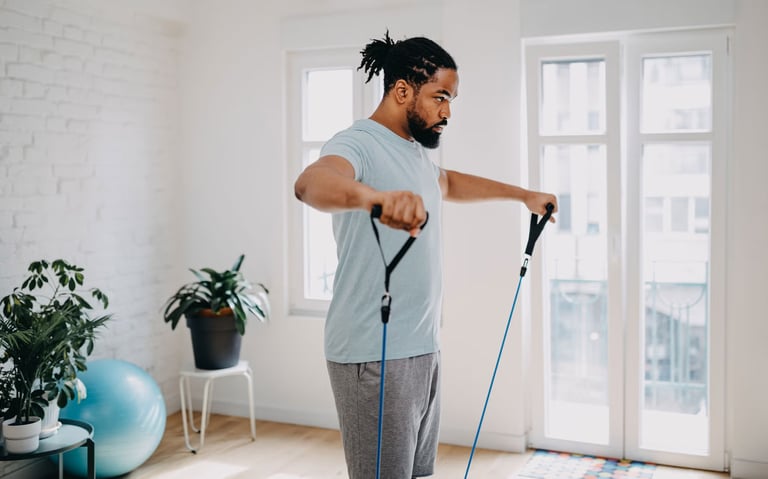Using Resistance Bands


Understanding Resistance Bands
Resistance bands are elastic bands used as a versatile tool for strength training and rehabilitation exercises. They vary in both shape and resistance levels, making them suitable for a wide range of fitness enthusiasts, from beginners to advanced athletes. Among the different types of resistance bands, loop bands and tube bands are the most common. Loop bands are continuous rings of thick rubber that provide steady resistance, while tube bands are characterized by their handle grips and are often used for more dynamic exercises. Therapy bands, which are typically lighter, are primarily designed for rehabilitation and therapeutic exercises, making them ideal for individuals recovering from injuries.
The primary appeal of resistance bands lies in their versatility. They can be used to perform a myriad of exercises targeting various muscle groups, including the arms, legs, and core. Whether utilized for strength training, flexibility exercises, or rehabilitation, resistance bands can easily adapt to the specific needs of users. This adaptability extends to the portability of resistance bands; they are lightweight and compact, allowing individuals to incorporate them into workouts at home, the gym, or even while traveling. Their simplicity makes them accessible for many, encouraging people to maintain an active lifestyle regardless of their circumstances.
Moreover, one of the most significant advantages of resistance bands is the concept of progressive resistance they offer. Users can easily adjust the intensity of their workouts by selecting bands of different thickness or by altering the length of the band during exercises. This progressive nature not only helps in building strength and endurance but also aids in preventing plateauing—a common issue faced in traditional weight training. Thus, the incorporation of resistance bands in fitness routines ensures a dynamic and efficient approach to achieving workout goals.
Benefits of Using Resistance Bands
Resistance bands have gained immense popularity in the fitness community due to their versatility and numerous benefits. One of the primary advantages of using resistance bands is their ability to help individuals build strength. Unlike traditional weights, resistance bands offer varied levels of resistance, making them suitable for both beginners and advanced fitness enthusiasts. This adaptability allows users to gradually increase their resistance, facilitating continuous strength progression over time.
Another notable benefit of resistance bands is their contribution to improving flexibility. The elastic nature of these bands enables users to stretch in a controlled manner, helping to enhance their range of motion. Regular use of resistance bands for flexibility training can result in increased overall mobility, which is essential for daily activities as well as athletic performance.
In rehabilitation settings, resistance bands play a crucial role in aiding recovery from injuries. They provide a low-impact option for individuals looking to regain strength and movement without the risk of overexertion. Physical therapists often recommend resistance bands to help patients perform targeted exercises, promoting muscle engagement and minimizing the risk of further injury.
Moreover, resistance bands are instrumental in enhancing balance and coordination. By incorporating these bands into workout routines, users engage stabilizing muscles that are often overlooked with conventional weights. This engagement is particularly beneficial for older adults and athletes alike, as improved balance can lead to fewer falls and enhanced athletic performance.
Many fitness enthusiasts have embraced resistance bands, praising their effectiveness. One user remarked, “Using resistance bands has transformed my workout routine, allowing me to achieve results I never thought possible.” This sentiment highlights the growing recognition of the multiple benefits that resistance bands offer for comprehensive fitness training.
Effective Resistance Band Exercises for All Levels
Resistance bands are versatile tools that cater to all fitness levels, making them an excellent option for enhancing strength, flexibility, and endurance. Below, we present a selection of effective exercises using resistance bands, complete with instructions and tips for proper technique.
Banded Squats (Beginner)
To initiate this exercise, step on the resistance band with both feet. Position the band across your shoulders for support. As you lower into a squat, ensure that your knees align with your toes, and keep your back straight. Rise back to the starting position and repeat for 10-15 reps. This movement targets the glutes and quads, providing foundational strength.
Seated Rows (Intermediate)
For seated rows, sit on the floor with your legs extended and wrap the resistance band around your feet. Holding the band with both hands, pull the band toward your torso while keeping your elbows close to your sides. Squeeze your shoulder blades together at the end of the movement. Aim for 12-15 repetitions to engage your upper back muscles effectively.
Single-Leg Deadlifts (Advanced)
To perform this complex exercise, stand on one leg while holding the resistance band with the opposite hand. Keep your back straight as you hinge at your hips to lower the band toward the ground. Return to standing, focusing on balance. Complete 8-10 reps on each side to challenge your stability and hamstring strength.
When using resistance bands, it's crucial to maintain proper form to prevent injuries. Consider incorporating visual aids, such as images or videos, to illustrate the execution of these exercises. Modifying these movements based on your fitness level can also maximize their effectiveness. For example, beginners may want to use lighter bands, while advanced users might opt for heavier resistance or add variations to the exercises.
In conclusion, resistance bands offer a dynamic way to engage in a comprehensive workout routine across all fitness levels. By integrating these exercises into your regimen, you can effectively target various muscle groups while enjoying the flexibility and accessibility that resistance bands provide.
Creating a Resistance Band Workout Routine
Establishing a workout routine using resistance bands can be an effective way to enhance your fitness levels. To create a plan tailored to your goals, consider several key components: frequency, duration, and progression. Firstly, aim to incorporate resistance band exercises into your schedule at least three times a week. This provides adequate stimulation for muscle growth and improves overall strength without leading to excessive fatigue or burnout.
Next, consider the duration of each workout. An effective resistance band session can range from 30 to 60 minutes, depending on your fitness level and the specific goals you are targeting. Beginners may benefit from shorter sessions focusing on mastering technique, while more advanced users can extend their routines to incorporate additional exercises and higher intensity. Always factor in a warm-up and cool-down phase to prevent injury and aid recovery.
Progression is a vital aspect of any workout routine, including those utilizing resistance bands. To continuously challenge your muscles, gradually increase the resistance level of the bands you use, increase the number of repetitions or sets, or incorporate more complex movements directly into your routine. This approach not only helps in building strength but also adds variety, making workouts more engaging.
Sample workout plans can be easily tailored for specific goals. For example, a full-body resistance band workout could include exercises such as squats, chest presses, and rows. Each exercise might be performed for three sets of 10-15 repetitions. To target specific muscle groups, individuals can create focused sessions—like an upper body day that incorporates overhead presses, bicep curls, and tricep extensions. Integrating different exercises within your routine can provide a comprehensive workout that supports your fitness aspirations.


